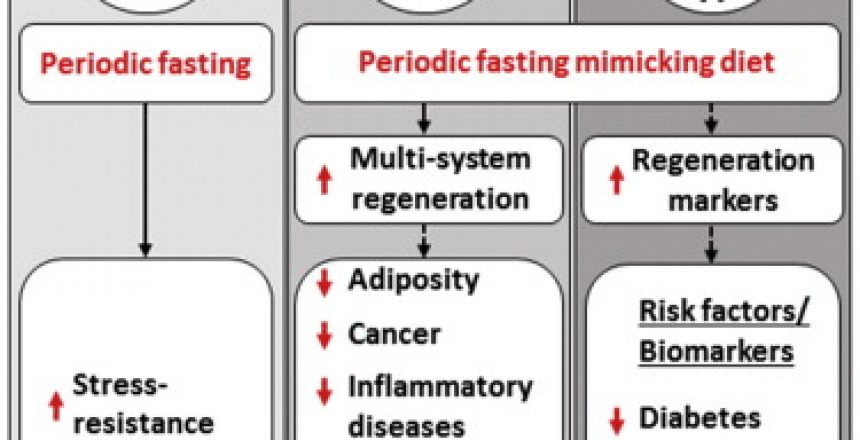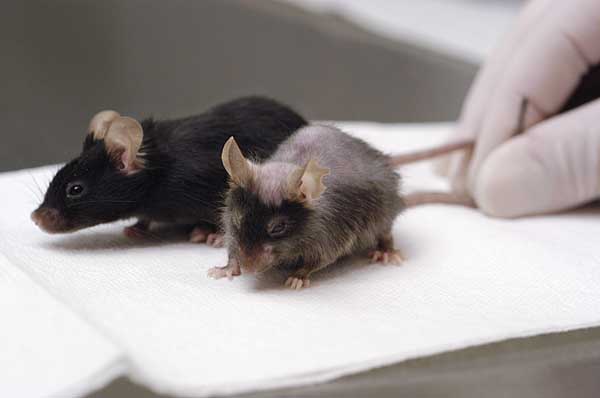Prolonged fasting and a fasting-mimicking diet
Restricting calorie intake (calorie restriction, CR) in experimental animals by 30% or more is the most robust and effective strategy known to date to slow the aging process, increase lifespan, and improve the health of old animals. Intermittent fasting (IF) is perhaps an even better strategy for doing this, since it avoids many of the problems of CR such as weakness, immune suppression, and constant hunger; in IF, total calorie intake is often no less than in constantly fed animals (or humans), or sometimes, only slightly less, because the subjects of IF, whether human or animal, usually make up for lost intake by eating more during feeding times.
Intermittent fasting is one of several strategies for slowing aging that I discuss in my new book, Stop the Clock: The Optimal Anti-Aging Strategy.
In the book I also discuss going beyond IF and into so-called prolonged fasting. In prolonged fasting, the fast is extended and lasts two days or more. The great advantage of prolonged over intermittent fasting seems to lie largely in the lowering of levels of IGF-1, the growth hormone which promotes aging as well as a number of diseases of aging, notably cancer.
The main problem with prolonged fasting is a practical one: hunger. While I’ve read a number of accounts of people fasting for several days, in real life I know of no one who would do it, and I suspect the number of people willing to do prolonged fasting is quite low.
What if one could develop a diet that mimicked the effects of prolonged fasting while alleviating some of the hunger that goes with it, making the process easier? A first step in that direction has now been taken.
Valter Longo, probably the most prominent scientist who has studied fasting, and colleagues, have done this, as shown in their new study, A Periodic Diet that Mimics Fasting Promotes Multi-System Regeneration, Enhanced Cognitive Performance, and Healthspan. (Cell Metabolism.)
The study looked at the effects of the fasting-mimicking diet in yeast, mice, and humans.
The diet
In humans, the diet lasted for 5 days a month for 3 months, and was designed to provide 34 to 54% of the normal amount of calories. Day 1 of the diet was 1090 calories – not terribly low – and days 2 through 5 were 725 calories a day. Days 2 through 5 had 9% protein, 44% fat, 47% carbohydrate; interestingly, even though carbohydrate percentage seems relatively high, the number of calories was low enough that the diet was ketogenic.
The results
Below is a figure from the article that shows the human results.
Fasting blood sugar dropped by 11% and remained 5% lower even after the subjects resumed regular eating. IGF-1 dropped 24% and remained 15% lower after refeeding. Body weight dropped 3%, and almost the entire loss was fat, not muscle. In those subjects with a high C-reactive protein, a marker of inflammation and cardiovascular disease risk, most dropped into the normal range.
In summary, this study indicates that FMD cycles induce long-lasting beneficial and/or rejuvenating effects on many tissues, including those of the endocrine, immune, and nervous systems in mice and in markers for diseases and regeneration in humans. Although the clinical results will require confirmation by a larger randomized trial, the effects of FMD cycles on biomarkers/risk factors for aging, cancer, diabetes, and CVD, coupled with the very high compliance to the diet and its safety, indicate that this periodic dietary strategy has high potential to be effective in promoting human healthspan. Because prolonged FMDs such as the one tested here are potent and broad-spectrum, they should only be considered for use under medical supervision.
This diet would seem to lower disease risk considerably. The beauty of it is that 1) compliance was high; most of the subjects were able to adhere to it, in contrast to what would presumably be a low adherence rate to a straight 5-day fast; 2) the prescribed number of calories and macronutrient ratio is fixed, so it takes much of the guesswork out of the equation; just eat what they tell you for 5 days and biomarkers of aging and disease should diminish.
As they say in the study, a prolonged fast like this one should be cleared with one’s doctor.
Personally, I’ve never managed to fast longer than 24 hours, but with a prescribed regimen like this one, I might be persuaded to do the FMD for 5 days.















21 Comments
Interesting article. Just on the topic of longer-than-24-hr fasts – there is a great article from Harper’s from a few years ago called, if I remember correctly, Starving Your Way to Vigor. The author fasted for 20 days. I currently only do 24-hour fasts, but I plan to start lengthening them considerably as I go past 40 and / or if I get cancer. Might start doing the five-day restrictions before then though.
As mentioned here before, I repeatedly went several days without eating during my desperate attempt to lose weight thirty years ago. I got pretty hungry at times, but the hunger always went away after awhile. I guess my glucose levels stabilized or something. By the time my eating day rolled around, I almost had to force myself to eat. I was a young guy in want of a girl in those days. That’s a strong motivator.
Judging from your picture, you are thin enough, Dennis. You don’t need to lose any more weight.
No, I don’t need to lose weight, but out of pure vanity I suppose I’m after them ripped abs, which I don’t have.
Yes, wanting a girl is a strong motivator. It’s what got me lifting weights.
Five years ago started doing Pilon’s Eat-Stop-Eat style fasting and simultaneously starting Body-by-Science type HIT resistance training, followed by “paleo” style eating, low-carbing, gluten-free, cod liver oil, etc.
I didn’t know then what part of the regimen caused the majority of health improvements I saw, but I’m pretty sure now that fasting and HIT were the most effective, and the evidence you present on this blog seems to confirm this. Current age is 62 years.
24-hour fasts are easy now — basically just skip a meal — but in May I fasted for 48 hours twice. Not a pure fast, I consumed between 70-90 kcals a day (in my morning coffee). The last 8 hours were really difficult. I made sure that the fast ended on a non-working day, because those last hours I was counting down the time to the end, and irritability was high. I may try this again later in the summer — in winter it’s just too tough.
I’m just wondering if I can become acclimated to a 48-hour fast the same way I did to a 24-hour fast.
I’m somewhat amazed that you (and Alex?) couldn’t go beyond 24 hours. My experience with multi-day fasts is the same as Big Fat Guy’s and Cristi Vlad’s: the first 24 hours are the worst, then you don’t really feel the need to eat anymore. I wonder if this is merely due to psychological expectation management, or if there are some physiological reasons for the different experiences.
Garymar’s comment just overlapped with mine, so I’d like to reply to his 48-hour report. In my experience, ANY amount of calories during multi-day fasting must be strictly avoided because the resulting insulin spike generates hunger! So no 70-90 kcal in the coffee. I had tried that once, drinking a cappuccino instead of black coffee during a fast, and I had to abort fasting the same evening due to craving more food.
I do agree that fasting is much easier in summer than winter, though. Without active digestion the body doesn’t generate nearly as much baseline heat — very convenient during summer, not so much during winter. Another fast I had to abort was during a cold spell in spring, it just got too uncomfortable.
Christoph, the calories I consume in my morning coffee are pure fat: about 2 grams of butter and 7-9 grams of MCT oil, i.e., the infamous “Bulletproof Coffee”. Also put creatine and l-tyrosine into it.
Seems to have no effect on appetite when I’m fasting.
Okay. Try to omit it anyway and see what happens. If you’re already comfortable with 24-hour fasts you shouldn’t be craving food after 40 hours, that’s why I suspect your bulletproof coffee might interfere. Of course it might just be the effect of winter cold.
You may be right. I’ll try it on the next one.
Hi Peter,
What was actually their diet so that I could mimic it?
Well, if you read the paper, it says that the mix was “proprietary”, so they’re trying to make some money from it I suppose. But if you follow the macronutrient ratio I outlined in my post, you would get the same results. In fact, I’m wondering if you couldn’t get the same results eating nothing but sour cream or similar, since there are no carbs or protein in sour cream. I bet you could.
Yeah, the article’s behind a paywall so that’s why I asked if the authors detailed the diet. I figured as much that they would keep the diet proprietary in order to market it at some point.
I was playing around with the calories and macros at eatthismuch dot com, which more or less gets you there. I would craft it as vegan in order to really sink IGF-1.
I’m sorry to ask, but since you’ve paid to read the article, is there any difference in the macros for Day 1 of the diet?
Thanks Peter
The article is actually open access, you should be able to read the whole thing. Under supplemental procedures (https://www.cell.com/action/showExperimentalProcedures?pii=S1550-4131%2815%2900224-7), under human diet, here’s what they say:
Not a whole lot of difference in the macros, mainly lower calories. Looking at the actual diet, frankly it looks crappy; I mean “energy bars, energy drinks”? I think I could do better with a whole foods diet, but I suppose there’s no guesswork with their diet.
Well that didn’t take long. Josh Mitteldorf has reported that the USC has started a spinoff company called L-Nutra. One of their products is the ProLon line, which is basically the fasting-mimicking diet in the Cell article.
https://joshmitteldorf.scienceblog.com/2015/07/08/fasting-mimicking-diet-a-disclaimer/
https://l-nutra.com/index.php/products/prolon
As a physician practicing health and wellness, I have been interested in the benefits of periodic fasting for myself and my patients. I just finished a 6 month self-experiment doing a 5 day fast each month using Lifebox. The food is tasty and enjoyable and I found it very doable. Best of all, I have lost 10 pounds and my HgbA1c is completely normal for the first time in years.
Interesting. Looks rather pricey, at $149 for 2 weeks worth of vegetarian packaged food.
Hi Dennis,
I believe 2 x avocados/ day cover the macro ratio pretty closely. That might be a whole-food, nutrient dense way of going about it?
Hi Rob, I’m not sure, though I think it would be healthy. I think Longo’s diet may have been higher carb, lower fat.